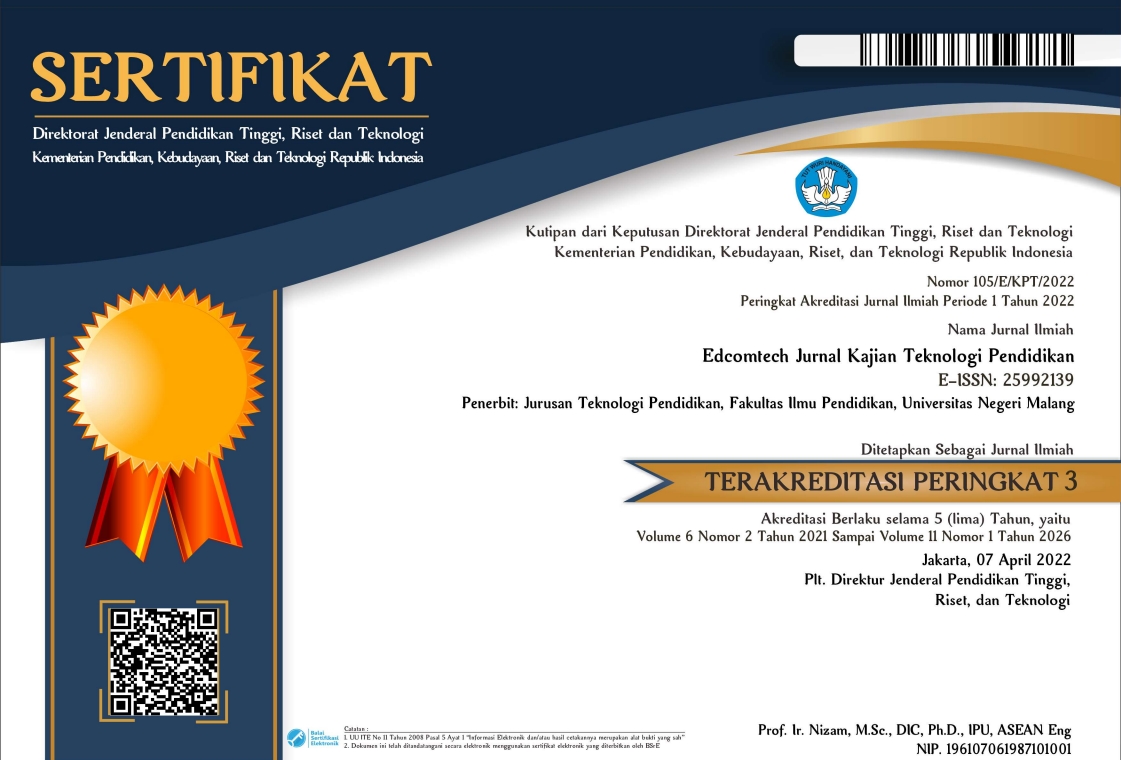Relation of Facial Expressions and Student Learning Outcomes in Face Recognition-Based Online Learning
Abstract
This research was conducted to determine the relationship between facial expressions and student learning outcomes based on face recognition. The applied learning is online, with nine respondents participating in statistics lectures. This type of research is quantitative research with inferential statistical analysis; the software used to detect facial expressions is LOBE software, while the data collection on learning outcomes uses multiple choice questions as many as ten. Based on the research results, there is a relationship between facial expressions and student learning outcomes, which are carried out through the person correlation test with a significance of less than 0.05, namely 0.001. The level of the relationship between the two is a perfect correlation based on the correlation guide table, which is equal to 0.895.
Keywords
Full Text:
PDFReferences
Amalia, R., Rosidah, L., & Fatimah, A. (2023). Hubungan latar belakang budaya orang tua terhadap pengasuhan anak usia dini. As-Sibyan; Jurnal Pendidikan Anak Usia Dini, 8(1), 111–122. https://doi.org/https://doi.org/10.32678/assibyan.v8i1.8293
Ayvaz, U., Gürüler, H., & Devrim, M. O. (2017). Use of Facial Emotion Recognition in E-Learning Systems. Information Technologies and Learning Tools, 60(4), 95–104. https://doi.org/10.33407/itlt.v60i4.1743
Carrillo, C., & Flores, M. A. (2020). COVID-19 and Teacher Education: A Literature Review of Online Teaching and Learning Practices. European Journal of Teacher Education, 43(4), 466–487. https://doi.org/10.1080/02619768.2020.1821184
Casino-García, A. M., García-Pérez, J., & Llinares-Insa, L. I. (2019). Subjective Emotional Well-Being, Emotional Intelligence, and Mood of Gifted vs. Unidentified Students: A Relationship Model. International Journal of Environmental Research and Public Health, 16(18), 1–18. https://doi.org/10.3390/ijerph16183266
Dixit, B., & Gaikwad, A. (2018). Facial Expressions Based Emotion Recognition Through Feature Fusion Approach. Proceedings of 2018 the 8th International Workshop on Computer Science and Engineering, WCSE 2018, 258–263. https://doi.org/10.18178/wcse.2018.06.046
Du, H., Shi, H., Zeng, D., Zhang, X.-P., & Mei, T. (2022). The Elements of End-to-end Deep Face Recognition: A Survey of Recent Advances. ACM Computing Surveys, 54(10), 1–42. https://doi.org/10.1145/3507902
Ekmekci, K., & Ozbay, S. (2021). Emotion Analysis using Facial Expressions in Video. European Journal of Science and Technology, 24, 523–527. https://doi.org/10.31590/ejosat.926478
Hikmatiar, H., Jufriansah, A., & Jayadin. (2023). Lobe Software’s Accuracy in Analyzing Human Facial Expressions. Engineering Science Letter, 2(01), 20–26. https://doi.org/10.56741/esl.v2i01.288
Jayasinghe, U., & Atukorale, A. (2019). Tracking Emotions Through Facial Expressions in Online Education Systems Based on Transient Emotion Peak. CFEDUCATION, 7–19. https://doi.org/10.33422/wcfeducation.2019.09.516
Jin, B., Cruz, L., & Goncalves, N. (2016). Deep Facial Diagnosis: Deep Transfer Learning from Face Recognition to Facial Diagnosis. IEEE Access, 4, 1–14. https://doi.org/10.1109/ACCESS.2020.3005687
Krithika, L. B., & Lakshmi Priya, G. G. (2016). Student Emotion Recognition System (SERS) for e-learning Improvement Based on Learner Concentration Metric. Procedia Computer Science, 85, 767–776. https://doi.org/10.1016/j.procs.2016.05.264
Lukman, H. S., Setiani, A., & Agustiani, N. (2023). Pengembangan Instrumen Tes Kemampuan Pemecahan Masalah Matematis Berdasarkan Teori Krulik dan Rudnick: Analisis Validitas Konten. Jurnal Cendekia : Jurnal Pendidikan Matematika, 7(1), 326–339. https://doi.org/10.31004/cendekia.v7i1.1761
Mancini, C., Falciati, L., Maioli, C., & Mirabella, G. (2022). Happy facial expressions impair Inhibition with respect to fearful facial expressions, but only when Task-related. Journal TOC, 22(1), 142–152.
Miolla, A., Cardaioli, M., & Scarpazza, C. (2022). Padova Emotional Dataset of Facial Expressions (PEDFE): A Unique Dataset of Genuine and Posed Emotional Facial Expressions. Behavior Research Methods, 1–16. https://doi.org/10.3758/s13428-022-01914-4
Niinuma, K., Ertugrul, I. O., Cohn, J. F., & Jeni, L. A. (2021). Synthetic Expressions Are Better than Real for Learning to Detect Facial Actions. Winter Conference on Applications of Computer Vision (WACV), 1247–1256. https://doi.org/10.1109/WACV48630.2021.00129
Niswara, R., Muhajir, M., & Untari, M. F. A. (2019). Pengaruh Model Project Based Learning terhadap High Order Thinking Skill. Mimbar PGSD Undiksha, 7(2), 85–90.
Pansare, A., & Shetty, M. (2017). Mood Detection Based on Facial Expressions. International Journal of Engineering Trends and Technology, 48(4), 200–204. https://doi.org/10.14445/22315381/ijett-v48p236
Raji, I. D., Gebru, T., Mitchell, M., Buolamwini, J., Lee, J., & Denton, E. (2020). Saving Face: Investigating the Ethical Concerns of Facial Recognition Auditing. AIES 2020 - Proceedings of the AAAI/ACM Conference on AI, Ethics, and Society, 145–151. https://doi.org/10.1145/3375627.3375820
Rapanta, C., Botturi, L., Goodyear, P., Guàrdia, L., & Koole, M. (2020). Online University Teaching During and After the Covid-19 Crisis: Refocusing Teacher Presence and Learning Activity. Postdigital Science and Education, 2(3), 923–945. https://doi.org/10.1007/s42438-020-00155-y
Rasmitadila, Aliyyah, R. R., Rachmadtullah, R., Samsudin, A., Syaodih, E., Nurtanto, M., & Tambunan, A. R. S. (2020). The Perceptions of Primary School Teachers of Online Learning During the Covid-19 Pandemic Period: A Case Study in Indonesia. Journal of Ethnic and Cultural Studies, 7(2), 90–109. https://doi.org/10.29333/ejecs/388
Rosyiddin, A. A. Z., Fiqih, A., Nugraha, H., Hadiapurwa, A., & Komara, D. A. (2023). The Effect of Interactive PowerPoint Media Design on Student Learning Interests. Edcomtech: Jurnal Kajian Teknologi Pendidikan, 8(1), 12–24.
S.P, A., S, P., & G, K. (2019). Facial Expression Analysis of Students in Classroom using Machine Learning Technique. International Journal of Current Advanced Research, 8(07), 1–5.
S, S., Kulkarni, R., G, R., A, S., Rajabishree, M., & T.P, D. (2019). Real-Time Emotion Recognition through Facial Expressions. International Journal for Research in Applied Science and Engineering Technology, 7(5), 72–76. https://doi.org/10.22214/ijraset.2019.5013
Saito, A., Sato, W., & Yoshikawa, S. (2020). Older Adults Detect Happy Facial Expressions Less Rapidly. Royal Society Open Science, 7(3), 1–9. https://doi.org/10.1098/rsos.191715
Scherer, R., Howard, S. K., Tondeur, J., & Siddiq, F. (2021). Profiling Teachers’ Readiness for Online Teaching and Learning in Higher Education: Who’s Ready? Computers in Human Behavior, 118(3), 1–16. https://doi.org/10.1016/j.chb.2020.106675
Sriyati, S. (2023). Analisis Korelasi Potensi Skolastik Dengan Kemampuan Akademik Siswa Kelas 12 Sman 1 Situbondo. Jurnal Pembelajaran Fisika, 11(4), 174–181. https://doi.org/10.19184/jpf.v11i4.35463
Sya’bania, N., Anwar, M., & Wijaya, M. (2020). Pengembangan Media Pembelajaran Berbasis Video Animasi dengan Model Pembelajaran Inkuiri Terbimbing untuk Meningkatkan Motivasi dan Hasil Belajar Peserta Didik. Journal of Chemical Information and Modeling, 4(1), 34–44. https://ojs.unm.ac.id/CER/article/view/19117
Tavakolian, M., Cruces, C. G. B., & Hadid, A. (2019). Learning to Detect Genuine Versus Posed Pain from Facial Expressions using Residual Generative Adversarial Networks. International Conference on Automatic Face and Gesture Recognition, 1–8. https://doi.org/10.1109/FG.2019.8756540
Tonguç, G., & Ozaydın Ozkara, B. (2020). Automatic Recognition of Student Emotions from Facial Expressions During a Lecture. Computers and Education, 148, 3–12. https://doi.org/10.1016/j.compedu.2019.103797
Ueda, Y. (2022). Understanding Mood of the Crowd with Facial Expressions: Majority Judgment for Evaluation of Statistical Summary Perception. Attention, Perception, and Psychophysics, 84(3), 843–860. https://doi.org/10.3758/s13414-022-02449-8
Wang, W., Xu, K., Niu, H., & Miao, X. (2020). Emotion Recognition of Students Based on Facial Expressions in Online Education Based on the Perspective of Computer Simulation. Complexity, 1–9. https://doi.org/10.1155/2020/4065207
Yang, G., Feng, W., Jin, J., Lei, Q., Li, X., Gui, G., & Wang, W. (2020). Face Mask Recognition System with YOLOV5 Based on Image Recognition 2020. 2020 IEEE 6th International Conference on Computer and Communications Face, 1398–1404. https://doi.org/10.1109/ICSIP52628.2021.9688725
Zadobrischi, E., Cosovanu, L. M., Negru, M., & DImian, M. (2020). Detection of emotional states through the facial expressions of drivers embedded in a portable system dedicated to vehicles. Telecommunications Forum TELFOR 2020, 1–5. https://doi.org/10.1109/TELFOR51502.2020.9306572
DOI: http://dx.doi.org/10.17977/um039v9i12024p1
Refbacks
- There are currently no refbacks.
Copyright (c) 2024 hamzarudin hikmatiar, Nursina Sya'bania, Berlian Hamsa

This work is licensed under a Creative Commons Attribution-ShareAlike 4.0 International License.
Edcomtech: Jurnal Kajian Teknologi Pendidikan published by Department of Educational Technology, Faculty of Education, State University of Malang in Collaboration with Asosiasi Program Studi Teknologi Pendidikan Indonesia (APS TPI) and Ikatan Profesi Teknologi Pendidikan Indonesia (IPTPI) with MoU.
Publisher Address:
Lab. Teknologi Pendidikan, Gd.E2, Lt.1
Fakultas Ilmu Pendidikan Universitas Negeri Malang
Jalan Semarang No 5, Kota Malang Kode Pos 65145
Email: edcomtech.fip@um.ac.id
========================================================================================================
| INDEXED BY | TOOLS | PLAGIARISM CHECK | ARTICLE TEMPLATE |
|

Edcomtech is licensed under a Creative Commons Attribution-ShareAlike 4.0 International License.
Edcomtech Statistics (Since July 13th, 2020)











1.png)








